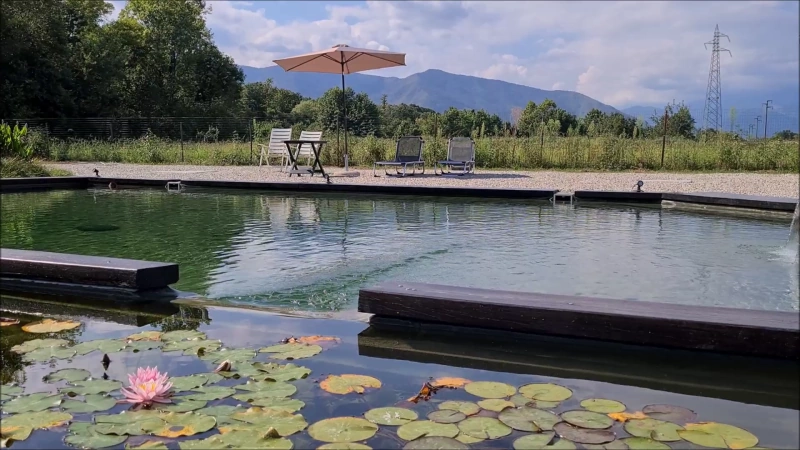
You are probably considering whether to build a conventional pool or a natural pool in your garden. In this article I want to tell you about the differences between a natural pool and a conventional pool.
In particular, we will look at the differences in terms of aesthetics, the feel of the water, technical and maintenance differences, as well as bureaucratic and cost differences.
A natural pool is somewhere in between an ornamental pond with aquatic plants and a swimming pool.
In a natural pool there is both a swimming area and an area with aquatic plants, so it is a way to bathe in a very beautiful, pleasant and natural environment.
It can come in a variety of designs, from the irregularly shaped pool which is more like a pond, to the more geometrically shaped pool which is more like a conventional pool.
The position of the plants can also be variable according to your taste. The plants can be placed in the same pool, or, much better, in a pool next to it, or even in a pool several metres away from the main swimming pool.
A conventional pool is only used in summer, and during the rest of the year it may be covered or emptied. On the other hand, a natural pool is always functional and beautiful in all 4 seasons, so it remains a decorative element of your garden even when not in use.
A big difference is that in a natural pool chlorine is not used.
In a conventional pool, chlorine must be added at a fixed frequency to stop algae growth and to stop the growth of harmful bacteria.
If chlorine is not added regularly, harmful bacteria have plenty of room to reproduce.
On the other hand, in a natural pool the water is phyto-purified by aquatic plants.
In addition, a natural ecosystem is created, also from a bacteriological point of view.
Thanks to the aquatic plants, colonies of beneficial bacteria are formed, which are responsible for phyto-purification, which make it impossible for malignant bacteria such as salmonella or legionella to establish in it.
There are numerous scientific studies that have shown that swimming in a chlorinated pool can cause irritation of the skin, eyes and mucous membranes of the respiratory tract. Swimming in chlorinated water can also cause symptoms of bronchial hyperreactivity, asthma and rhinitis, especially in children and frequent pool swimmers.
The chlorine problem does not exist in a natural pool and it should not be used for any reason.
Aquatic plants perform the function of phyto-purification because through photosynthesis they release oxygen into the water through their leaves and roots.
In the substrate in which they are planted, aerobic bacteria are formed, i.e. bacteria that need oxygen to perform their functions.
These bacteria are called nitrosomonas, nitrobacter and nitrospira, and are the ones that transform pollutants such as phosphates and nitrogenous substances into harmless substances that can be used by plants as nutrients.
In addition, pollutants such as heavy metals are also absorbed by aquatic plants.
The end result is clean, transparent, odourless water with a pleasant sensation for the skin, eyes and mucous membranes.
From a constructional point of view, there are significant differences between a natural pool and a conventional pool.
First of all, in a natural pool there are two pools, one for plants and one for swimming, and they are typically made of a liner instead of concrete, also to give it a more natural pond-like appearance.
In terms of technology, a pool usually has a sand filter and pumps with high flow rates, which also corresponds to a very high electricity consumption.
On the other hand, in the case of a natural pool, we have pumps with very low flow rates in order to continuously pass the water between the swimming area and the plant area.
In a natural pool we use pumps that consume 80-100 w, therefore very low compared to conventional pool pumps that typically consume 1500-2000 w.
Then instead of sand filters we use biological filters that complete the work of phyto-purification of the plants. In these filters there are usually sponges inside which the same bacteria responsible for phyto-purification are formed, which are also found in the roots of the plants.
Regarding the maintenance, chlorine is used to maintain hygiene in a conventional pool in the form of tablets, which together with chlorine also contain isocyanuric acid, which is a stabiliser.
Therefore, in the water must always be a certain percentage of isocyanuric acid in combination with chlorine. If there is not enough of it, the chlorine evaporates and it does not do its job. Neither too much of it, it is reccomended, as the chlorine loses its effectiveness and also becomes a health hazard for users.
A major problem with the maintenance of a conventional pool is that the isocyanuric acid remains in the pool and does not degrade.
In a conventional pool, the water needs to be changed periodically, at least partially, and this also causes an environmental problem, as water containing this acid is dispersed.
In a conventional pool you would have to check the pH of the water daily to make sure that everything is OK, because if there is something wrong, it’s a health hazard.
Obviously, there are not all these problems of water control, isocyanuric acid and water replacement in a natural pool!
The only maintenance work in a natural pool is to cut the dry parts of the plants during the winter, and the routine cleaning of the bottom of the swimming area, which can be done with a vacuum cleaner or a robot as in a conventional pool.
Another important difference between a conventional pool and a natural pool concerns bureaucracy.
In fact, building a conventional pool means having to apply for a permit from the municipality. In addition, a pool can increase taxation on a house because it makes it a luxury home.
Regarding the natural pool, we have the chance of making it looks like a conventional pool or a pond, depending on how it is built.
A natural pool built with a liner, without a concrete structure, making it looks as much as possible like a pond with lots of aquatic plants, certainly simplifies life from the point of view of bureaucracy.
Finally, the last topic of comparison concern the cost of construction.
If you want a turn key natural pool, the cost of construction of a natural pool is comparable to that of a conventional pool, but the maintenance cost of a natural pool is extremely lower. I examined the cost of a natural pool in this article.
Moreover, it is also possible to drastically reduce the cost of construction and at the same time obtain a result that is certainly better than that of any company specialized in the construction of ponds or swimming pools.
You can achieve this by doing a do-it-yourself job by faithfully following our DIY Natural Pool course which includes our advice and assistance and a video course that we created by filming all the stages of construction of our natural pool.
In the video course there are dozens of videos showing how to build a natural pool step by step. You will see everything that has been done to build our pool, with related explanations, without hiding any secrets.
In this way you will be able to build your own pool, smaller or bigger than this one, on your own or with the help of a friend, gardener or builder who will have to follow the video course.
You can find all the details on this page!
Currently only the Italian version is available. We are working on making it available in other languages soon.

